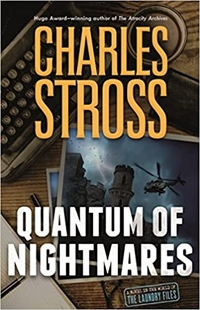The Appeal by Janice Hallett
 Monday, January 24, 2022 at 7:40AM
Monday, January 24, 2022 at 7:40AM 
Published in the UK in 2021; published by Atria Books on January 25, 2022
A character in The Appeal knows a secret. That character is murdered to keep the secret from coming out. What is the secret? Which character will die? Who is the murderer? Those questions propel this delightfully unconventional epistolary novel.
A barrister gives a collection of documents — primarily texts, WhatsApp messages, and emails, although police interview transcripts, memos, and a few other documents are later added to the pile — to two law students. He asks them to read the documents without context and to answer some questions: Who committed the murder? Who knew it was going to happen? What three things did the victim tell people before the murder? Who knew about the murder before the body was discovered? Who has been wrongly imprisoned for the crime? Who of the named people are not who they say they are?
The action surrounds an amateur theater group called The Fairway Players. Martin Hayward, a respected local businessman, chooses and directs the plays. His talented wife Helen plays the female lead. His daughter Paige usually plays a role. His son James is his assistant director. James’ wife Olivia is pregnant with twins so James’ time is limited. When the document dump begins, they are casting for All My Sons.
This production differs from others because Martin must devote his time to raising funds for his granddaughter Poppy, who is undergoing treatment for a brain tumor. Dr. Tish Bhatoa is sourcing experimental drugs from the US, but Martin will need a large sum of money (the total changes from time to time) to acquire them. He eventually does a fundraising appeal with other members of The Fairway Players. The appeal is managed by Sarah-Jane MacDonald, who has fundraising experience.
Samantha Greenwood and her husband Kel are newcomers to the group. They just returned to England from Africa, where they were relief workers. Samantha has some history in Africa with Dr. Bhatoa, who warns Martin that she is not to be trusted. Samantha meets Isabel (Issy) Beck at the hospital where they are both employed as nurses. Issy latches onto Samantha and recruits her (and Kel) to The Fairway Players. Issy desperately wants attention and is slavishly devoted to anyone who gives it to her, but most members of the group have a low opinion of her. Issy lives in a fantasy world and soon imagines that Samantha is her new best friend.
The fundraising takes unexpected turns as a potential donor disappears after asking questions about the miracle drugs that Dr. Bhatoa refuses to answer. An investment manager who promises to multiply the donations apparently disappears with the money. Sarah-Jane and others tell fibs (“Poppy is going blind!”) to encourage others to help with the appeal. Suspicions are formed, accusations are made, and eventually someone dies. The reader soon begins to question every fact related to the fundraiser and later to the murder.
Janice Hallett brings out the personalities of characters through their texts — Dr. Bhatoa is brusque, Issy is clingy, Martin is evasive, Samantha is principled. Each question that the barrister poses might have various plausible answers. The law students change their view of the evidence as they review the documents and acquire more information. The reader will do the same.
The novel is a true mystery, a whodunit mixed with uncertainty about what actually happened that led to the death. The novel’s construction, inviting the reader to tease the truth out of primary source documents, engages the reader’s attention and challenges the reader’s detective skills. Simply because of its structure, The Appeal is among the most innovative and entertaining crime novels I’ve read in recent years.
RECOMMENDED
 TChris |
TChris |  Post a Comment |
Post a Comment |  Janice Hallett,
Janice Hallett,  UK in
UK in  Thriller
Thriller 


